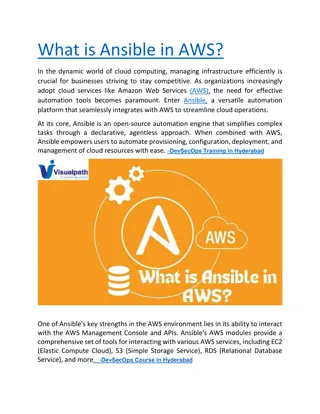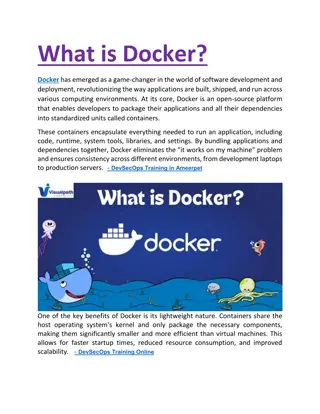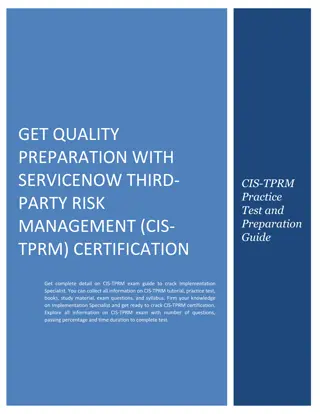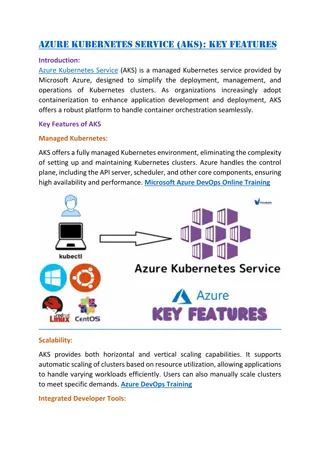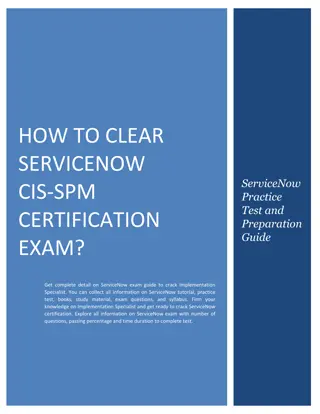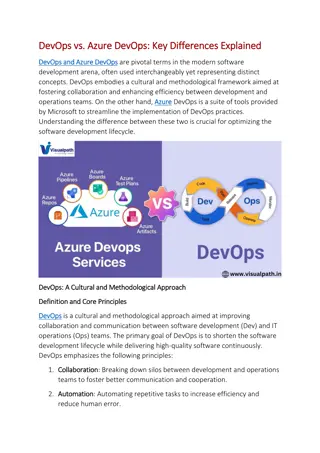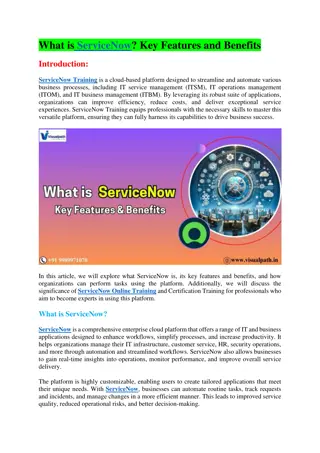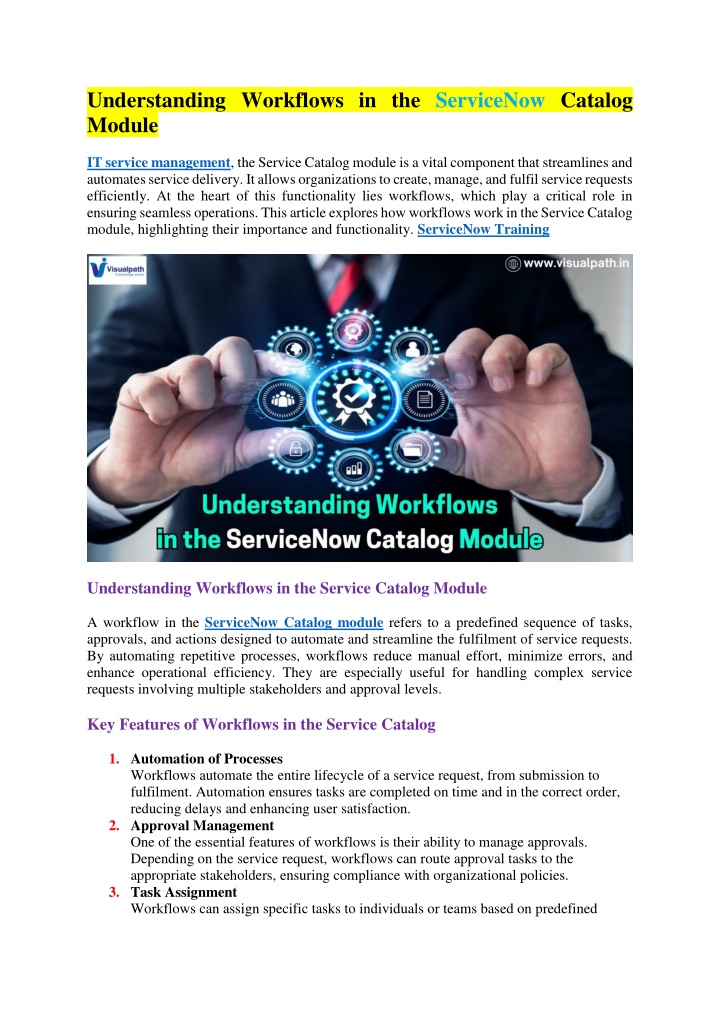
Best ServiceNow - ServiceNow Online Training
Join VisualPath for the best ServiceNow Certification Training with expert guidance and hands-on learning. Our training covers procurement, sourcing, and supplier management tools to strengthen supplier relationships. Learn from seasoned professional
Uploaded on | 1 Views
Download Presentation

Please find below an Image/Link to download the presentation.
The content on the website is provided AS IS for your information and personal use only. It may not be sold, licensed, or shared on other websites without obtaining consent from the author. If you encounter any issues during the download, it is possible that the publisher has removed the file from their server.
You are allowed to download the files provided on this website for personal or commercial use, subject to the condition that they are used lawfully. All files are the property of their respective owners.
The content on the website is provided AS IS for your information and personal use only. It may not be sold, licensed, or shared on other websites without obtaining consent from the author.
E N D
Presentation Transcript
Understanding Workflows in the ServiceNow Catalog Module IT service management, the Service Catalog module is a vital component that streamlines and automates service delivery. It allows organizations to create, manage, and fulfil service requests efficiently. At the heart of this functionality lies workflows, which play a critical role in ensuring seamless operations. This article explores how workflows work in the Service Catalog module, highlighting their importance and functionality. ServiceNow Training Understanding Workflows in the Service Catalog Module A workflow in the ServiceNow Catalog module refers to a predefined sequence of tasks, approvals, and actions designed to automate and streamline the fulfilment of service requests. By automating repetitive processes, workflows reduce manual effort, minimize errors, and enhance operational efficiency. They are especially useful for handling complex service requests involving multiple stakeholders and approval levels. Key Features of Workflows in the Service Catalog 1.Automation of Processes Workflows automate the entire lifecycle of a service request, from submission to fulfilment. Automation ensures tasks are completed on time and in the correct order, reducing delays and enhancing user satisfaction. 2.Approval Management One of the essential features of workflows is their ability to manage approvals. Depending on the service request, workflows can route approval tasks to the appropriate stakeholders, ensuring compliance with organizational policies. 3.Task Assignment Workflows can assign specific tasks to individuals or teams based on predefined
criteria. This ensures accountability and prevents delays caused by unclear task ownership. 4.Notifications and Alerts To keep all stakeholders informed, workflows can generate automated notifications and alerts at various stages of the process. These updates improve transparency and ensure that no critical steps are overlooked. 5.Conditional Logic Workflows in the Service Catalog module can include conditional logic to handle different scenarios. For instance, a service request may follow different approval paths based on its priority or type. ServiceNow Online Training How Workflows Operate in the Service Catalog Module 1. Request Submission The workflow process begins when a user submits a service request through the Service Catalog. The request includes details such as the service type, priority, and any additional information required for fulfilment. 2. Triggering the Workflow Once the request is submitted, the associated workflow is triggered automatically. This initiation ensures that the process starts immediately without manual intervention. 3. Approval Routing If the service request requires approvals, the workflow routes it to the appropriate approvers. For example, a request for new software might need approval from the IT manager or a department head. 4. Task Assignment After approval, the workflow assigns tasks to the relevant teams or individuals. For instance, if the request involves hardware procurement, the workflow may assign tasks to the procurement and IT support teams. 5. Monitoring and Escalations Throughout the process, the workflow monitors the progress of each task. If any delays occur, escalation mechanisms can be activated to ensure timely resolution. 6. Completion and Closure Once all tasks are completed and the service is delivered, the workflow automatically updates the status of the request to "Closed." This marks the end of the process and provides a record of fulfilment for future reference. Benefits of Using Workflows in the Service Catalog 1. Enhanced Efficiency
Automating service request processes eliminates manual bottlenecks, allowing teams to focus on more strategic tasks. 2. Improved Accuracy By automating repetitive tasks, workflows minimize the risk of human error, ensuring consistent and reliable outcomes. 3. Faster Service Delivery Workflows streamline task execution and approvals, reducing the time required to fulfill service requests. 4. Increased Transparency Stakeholders have visibility into the status of service requests at every stage, fostering trust and accountability. 5. Scalability Workflows can handle a high volume of service requests, making them ideal for growing organizations. ServiceNow Certification Training Best Practices for Designing Effective Workflows 1.Understand User Requirements Before creating a workflow, gather input from users to understand their needs and pain points. This ensures the workflow aligns with organizational goals. 2.Use Conditional Logic Wisely Incorporate conditional logic to handle different scenarios efficiently. This flexibility ensures that the workflow adapts to varying requirements. 3.Test Thoroughly Before deploying a workflow, test it in a controlled environment to identify and fix any issues. A well-tested workflow ensures a smooth implementation. 4.Monitor and Optimize Regularly monitor the performance of workflows to identify areas for improvement. Optimization ensures workflows remain efficient as organizational needs evolve. 5.Ensure Compliance Design workflows to comply with organizational policies and regulatory requirements. This avoids potential legal and operational issues. Conclusion Workflows in the ServiceNow Catalog module are indispensable for automating and streamlining service request processes. By leveraging features such as automation, approval management, and task assignment, workflows enhance efficiency, accuracy, and transparency. Organizations can design effective workflows by understanding user needs, incorporating conditional logic, and continuously optimizing processes. With the right
approach, workflows can transform the Service Catalog module into a powerful tool for delivering exceptional IT services. Visualpath is the Best Software Online Training Institute in Hyderabad. Avail complete ServiceNowTrainingworldwide. You will get the best course at an affordable cost. Attend Free Demo Call on - +91-9989971070. WhatsApp:https://www.whatsapp.com/catalog/919989971070/ Visit Blog:https://servicenowonlinecrouse.blogspot.com/ Visit:https://www.visualpath.in/servicenow-online-training-in-hyderabad.html







